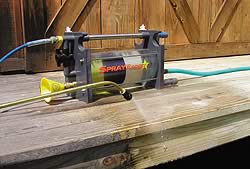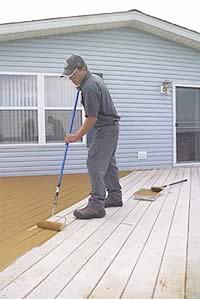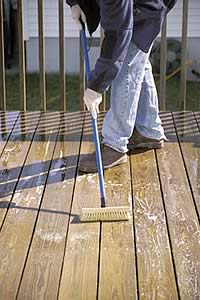
…continued from previous page
Wood Decks, Restoring & Maintaining Wood Decks
Restoring and maintaining wood decks can be a profitable niche. The toughest restoration jobs involve stripping multiple layers of old coatings down to bare substrate. Sometimes all a tired deck needs is a good washing.
by David Thompson
If multiple layers of old coating have piled up on the deck over the years, or if the homeowner wants to restore the natural look of the wood (and the wood isn’t too weathered to turn the clock back on), then stripping the deck down to bare substrate is called for. When it’s not immediately obvious whether or not a deck has a coating, the “splash test” comes in handy. Spill a cup of water on the deck: if it beads up, there’s a coating. If it soaks in, there’s not.
Sanding is one way to get down to bare wood. It’s such a hassle that some contractors call in professional floor stripping companies to do the work. A variety of stain and seal removers can also be employed.
Stain and seal removers tend to darken the wood, which is one reason they are typically followed with a deck brightener or reviver, both of which typically contain oxalic acid. Brighteners and revivers with oxalic acid also neutralize many stain and seal removers, ensuring that residue won’t weaken subsequent coatings. It’s a point contractors overlook at their peril, warns Steve Revnew, director of marketing for Sherwin-Williams in Cleveland. “If you just use the stain and seal remover, and don’t neutralize them, it could actually cause premature coating failure,” Revnew says.
Most stains and sealers can’t be applied until the deck has dried thoroughly, which generally takes 24 to 72 hours. A moisture meter, which has a nail-like probe that’s tapped into the end of a board, can take the guess work out of determining if the deck has dried long enough. Butler uses one routinely. “A lot of times a deck will look dry, and you stick the meter in and see that it’s not really,” says Butler, who considers a deck sufficiently dry when its moisture content reaches 18 percent.

Applying stain is relatively easy, compared to the prep work. “Most good stains work by themselves,” says Brett Reily, marketing manager for Cabot Wood Care Products in Newburyport, Mass. “They do their own leveling, their own penetration, their own coverage — all the things they’re supposed to do when they spill out of the can. It’s the cleaning beforehand that’s important.”
Stains can be brushed or rolled on, but many contractors prefer to spray them on. Others like to use sponge mops for applying stains because they put plenty of product down while picking up any excess. Hand-pumped garden sprayers are a popular applicator not only for stains and sealers, but also for brighteners, revivers and cleaners. “Most guys use garden sprayers because they don’t want to run caustic chemicals through their airless sprayers,” says Kelly Dornbush of Cayucos, Calif., who manufactures an alternative spray applicator called SprayRanger that automatically dilutes wood treatment chemicals and harnesses pressure from a garden hose to apply them. When chemicals are sprayed onto a deck, deep spots can be thinned out with a brush.
Deck stains range from perfectly clear to completely opaque, with lots of gradations in between. Clears can showcase a young wood’s beautiful grain, while opaques can hide the ravages of time. In general, the further up the opacity scale you go, the more protection and durability you get and the longer the coating will last. The clearest of the clear may not last a year, while the most opaque may be good for up to five years. Also, clears won’t block ultraviolet light, which turns wood gray.

If a deck is just getting a maintenance coat, rather than a refinishing, it’s usually best to apply the same product that was previously applied, after sanding and scraping to remove anything that’s flaking or peeling. Some coatings adhere to themselves well while others don’t, so testing might be required. The four-ounce sample cans many manufacturers provide are perfect for tests.
Once a contractor has restored a weathered deck, the door is wide open to sell the homeowner on a regular maintenance program to keep the deck looking its best for as long as possible. For painters who aren’t put off by decks, maintenance programs can offer a steady source of income.
“People for the most part don’t want anything to do with taking care of their own decks,” says Butler. “They’ll tackle the side of their houses before they’ll tackle their decks. I tell them how the deck’s going to look if they don’t do anything to it, and usually they’re open to having someone maintain it.”

|

